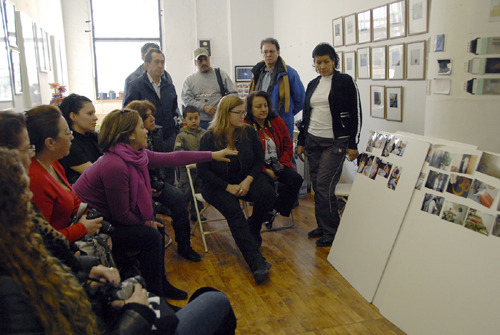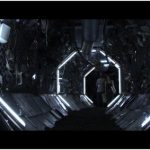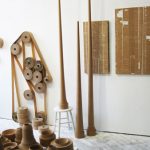Con Edison Immigrant Artist Program Newsletter, Issue No. 24
Featured Organization: New New Yorkers (NNY)
This month, the IAP features the New New Yorkers (NNY) Program, a partnership between the Queens Museum of Art (QMA) and the Queens Library (QL) to design and implement cost-free courses for immigrant adults in Queens. Art and literacy education for immigrants has no shortage of beneficiaries in Queens, the most diverse county in the United States. With more than 45% of its residents foreign-born, the borough is home to thriving Irish, Korean, Chinese, Greek, Indian and Argentinian communities, among many others. Amidst this cultural mix, the QMA uses its resources as a major art museum and educational center to focus on access for a wide range of audiences, curating art exhibitions that reflect the diversity of the borough and spearheading audience-driven programming to meet the needs of adult immigrants.
As part of QMA’s educational initiatives, NNY focuses on providing arts, technology and English language acquisition training, giving all participants a chance to explore the role of the arts in education and daily life. Courses that have been offered include Korean Bookmaking, Digital Storytelling, Photoshop and Bengali Dance, and are taught by New York-based artists in a variety of languages. IAP Program Officer Karen Demavivas interviews NNY Programs Manager José E. Rodríguez to learn how NNY continues to develop as a vehicle for cross-cultural exchange.
IAP: How has the Queens Museum of Art’s past community outreach shaped the conception of the New New Yorkers (NNY) Program?
JR: Under Tom Finkelpearl’s direction, the Queens Museum of Art (QMA) has made a decisive commitment to become “the most community engaged museum” in the nation. In Queens, our surrounding communities are mostly foreign-born and we believe that the museum’s programming should reflect that. A lot of our programming can be seen as a series of experiments in trying to become such a place. From that background arose a very courageous approach to Curatorial endeavors, backed by a strong Education Department, and a very receptive Events Department. (Early on, we separated our Events and Education Departments so that the Events Department can pursue community partnerships more aggressively, and the Education Department can take on longer lasting relationships with our surrounding populations.) The New New Yorkers Program comes out of the Education Department at QMA, and it is meant to provide quality programming to our surrounding adult immigrant populations.
IAP: How does this program reach out to immigrant communities now?
JR: We reach out by inviting local-international artists to share their work with these communities through free classes, exhibits and lectures. The most meaningful relationships have been forged through the courses. These occur in the languages of the participants (Spanish, Mandarin, Korean, Tibetan, Portuguese, Farsi, Croatian and Bengali to name a few), and they are meant to serve two purposes: to familiarize immigrant adults with the dynamics and themes behind contemporary art, and to reinforce skills in Arts, Digital and English Literacy. But I should point out that even our English courses are centered on art, and use our collections-or those of other museums-as a starting point.
A lot of outreach is done through our community partner, the Queens Library. The QL is the busiest public library system in the nation (largest in circulation; second largest in number of volumes), and they are very much in touch with the various communities of Queens.
IAP: How did your partnership with the Queens Library form and how did your organizations jointly develop the NNY Program?
JR: The partnership came about when the two directors at each institution decided to work together. We both shared similar goals but in different ways: the QL wanted to provide better quality arts programming to their immigrant audiences, and the QMA wanted to do outreach and audience development within the same community. QMA has the collections, educators and access to artists to implement the type of programming that the library wanted, and at the same time, such programming would be easier to do through the mechanisms that the QL already counted with for community outreach.
It took about two or three iterations to find our working model. At first, we both thought that Artist Lectures in native languages at the QL and ESOL classes at the museum were the way to go, but what we found out was that the participants in these activities wanted more hands-on practice in the disciplines that they were hearing about. They were learning about why contemporary art looks the way it does, and now they wanted to experience making some of it by themselves. At their behest we started offering longer educational experiences in the form of weekly classes lasting 2 months-mostly in the arts-along with gallery discussions at the museum. All classes were taught by immigrant artists in their native tongue. Our students had taught us a very important lesson: that there are many aspects to being an immigrant other than status. They have many areas of interest and skills, and this type of quality-of-life programming can be very instrumental to them having a fuller life in our city, because they are not deferring their dreams and aspirations to some distant future when they will have fulfilled all their language and civic requirements. Sure, we are aware that status and citizenship are important matters, and that’s where the QL comes in. They provide a wide range of services in those areas that we cannot cover, and we refer our students to them for that. They do the bread and we do the roses!
IAP: Can you tell us about the NNY Student Council: how it came to be, its goals and the people involved?
JR: The New New Yorkers Student Council came after meeting some colleagues at theHammer Museum in UCLA. They have a student association, with a budget, where students from various disciplines organize around museum exhibits and projects and put to practice their various skills writing museum materials and taking part in various curatorial efforts. We thought about how some of our students had built up some of the same skills and would probably jump at the chance to pursue some of their own projects with our support. We put a modest budget in place and asked them to elect a board and form a council with the larger student body. We had a very particular situation because most of the students are more comfortable in their own language-with Spanish and Mandarin having the strongest representation-so we decided to make ‘viumvirates’ out of the positions that require leadership and communication. Hence we have a 6-member board with 2 coordinators (one Spanish speaking and one Mandarin speaking), a Treasurer, a Secretary, and 2 public relations officers (again, in Spanish and Mandarin speaking). During the course of the next year they will be doing open calls, events, and maybe even small exhibitions at our Partnership Gallery to put to practice some of what they have been learning. It is a completely new thing for us, and at the moment we don’t know what to expect from it, but since they have fiscal authority we hope to find out where some of their interests and priorities truly lie.
IAP: How do you recruit multilingual artists who can teach a relevant but varied skill set?
JR: By networking with other departments within QMA, and with other arts institutions, artists are approached about teaching opportunities and asked to design courses centered on their work, or the skills involved in their practice. To me the most important standards are that the artist feels passionate about their work, and equally passionate about sharing their work and skills with the community. We are open to all disciplines, but we do have a special interest in interactive and studio art.
IAP: What has been the impact of the NNY Program on your constituents thus far?
JR: In 2010 we served 780 participants directly through courses, and about 5,000 indirectly through exhibits, family events and cultural festivals. During that year we also started implementing Collaborative Action Research on many of our classes to get more details on the impact and efficacy of our programs. Some of the findings were expected; like participants demonstrating increased confidence in everyday activities at work or at home, and feeling more confident when speaking English and discussing a variety of subjects. Some students have also ventured into different enterprises through skills gained at some of our more technical courses like photography or web design. Many of them are reporting increased attendance to other artistic venues around the city.
But there were some unexpected results as well. For example, students associate our program with stress-relief. Others say that now they feel more at ease knowing what their children are doing online now that they can handle computers. This one is particularly interesting because we were aiming at bridging cultural divides, but we had never thought of the generational divides that occur within the family nucleus because of immigration. Also many students asked to join classes whose language they did not speak, and many of those completed the course with the help of the other students. Stepping out from your comfort zone can be a very courageous act in this context. Many students made study groups around the subjects they were learning, and sought further instruction on the subjects learned through us. I view this as a success, because now they have additional motivations to learn the language.
We are just starting to gauge through surveys and observation exactly how our students are interacting with the cultural life of New York City, and whether we are enhancing that experience.
IAP: How can artists, activists and culture workers get involved in your activities?
JR: International artists are encouraged to contact me to learn about opportunities at NNY. Sometimes we don’t have something for them right away, but we keep a list of contacts, and artists are contacted about opportunities as they arise within the program, or within QMA at large. If we meet someone who we feel can make a good contribution to our museum, we always look for ways to work with them. Sometimes I have even contacted people one year after meeting them because a colleague asked something along the lines of “Do you know anybody who does this?”





